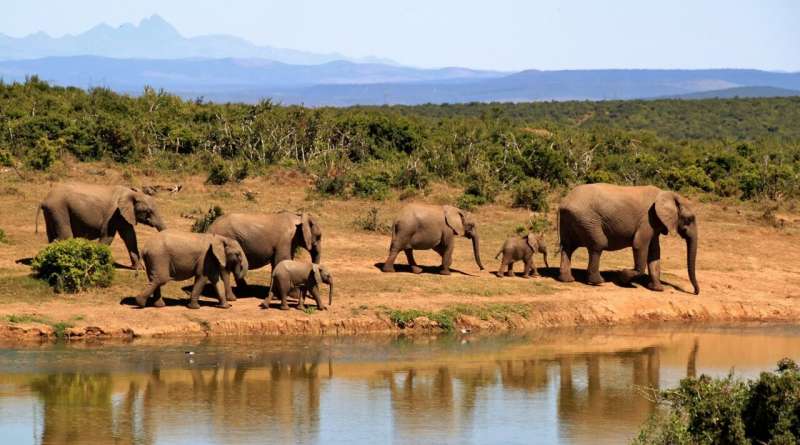New study finds strengthening protection of existing parks is crucial for biodiversity conservation

In a new study, bioscientists argue that strengthening the protection given to areas already protected under law or by local communities is as critical for safeguarding biodiversity as creating new protected areas.
The research team, which included scientists from Durham University, National University of Singapore (NUS) and Princeton University, found that about 70% of the roughly 5,000 species analyzed either have no apparent representation in protected areas, occur in protected areas that have been downgraded, downsized or degazetted, or would be especially vulnerable to extinction from future land-use change.
But, by enhancing the protection of existing protected areas, and by expanding the existing park networks across just 1% of the planet’s land area, the essential habitats of 1,191 animal species that are especially at risk of extinction can be protected.
The study has been published in the journal Science Advances.
Protected areas can be vulnerable to harmful human activities if there is insufficient enforcement or a lack of political backing for wildlife conservation.
Parks become less effective at protecting species when they experience such downgrading, downsizing or degazettement (PADDD) events, which occur when a government decides to roll-back the legal protections governing a park, diminishing the degree or extent of protection afforded to it.
These changes could result in forest clearance for infrastructure expansion, mining or other activities, and translate to the loss or degradation of habitats. As of 2021, over 278 million hectares of parks are known to have been cumulatively subject to PADDD events, the researchers found.
For example, Megophrys damrei is a critically endangered frog found only in Cambodia and nowhere else in the world. Even though its habitat is protected, the area continues to experience habitat degradation and loss within national park boundaries and in the adjacent surroundings.
Additionally, expanding the protected area network could benefit species whose habitats currently lack sufficient protection. For instance, the study found that protecting an additional 330 square kilometers of natural landscapes within Indonesia would safeguard the suitable habitats of 53 species that currently lack protected area coverage and have limited area of habitat.
For example, the Sangihe golden bulbul is a critically endangered songbird species found only on Sangihe Island in Indonesia and nowhere else in the world. Estimates put the entire population of the species at between 50 and 230 individuals remaining at one site, which is not protected. This species is absent from plantations, suggesting it is a sensitive species that can only thrive in good forests and would benefit from enhanced conservation.
Reflecting on the research findings, Dr. Rebecca Senior of Durham University, said, “There are many wonderful examples in conservation of people fighting to protect species, but there is always a risk that when you take your eye off the ball, pressure builds, and hard-won protection is lost.
“Designating parks on paper is not enough; they need to be in the right places, with the right management, and they need to last.”
Lead author of the study, Dr. Zeng Yiwen of NUS, said, “This study establishes a geography of arks: Where new parks can be created, and where to restore and reinforce existing parks, to boost wildlife conservation.”
“Many global discussions on conservation rightfully center around the need to create new protected areas. These include discussions at the COP15 United Nations biodiversity conference in December 2022, where a target to protect 30% of the planet’s lands and seas was adopted. But our study also shows the importance of ensuring that protected areas remain effective at keeping out harmful human activity.”
The findings of the new study come amid growing recognition of the need to conserve the planet’s biodiversity by creating new protected areas. At the United Nations biodiversity conference COP15 in December 2022, for example, countries had agreed on a target to set aside 30% of the planet’s lands and seas as protected areas.
The latest research sheds light on another important aspect of wildlife conservation: ensuring that already protected areas, or parks, continue to remain a safe space for biodiversity.
More information:
Yiwen Zeng et al, Gaps and weaknesses in the global protected area network for safeguarding at-risk species, Science Advances (2023). DOI: 10.1126/sciadv.adg0288. www.science.org/doi/10.1126/sciadv.adg0288
Citation:
New study finds strengthening protection of existing parks is crucial for biodiversity conservation (2023, June 2)
retrieved 2 June 2023
from https://phys.org/news/2023-06-crucial-biodiversity.html
This document is subject to copyright. Apart from any fair dealing for the purpose of private study or research, no
part may be reproduced without the written permission. The content is provided for information purposes only.
For all the latest Science News Click Here
For the latest news and updates, follow us on Google News.

